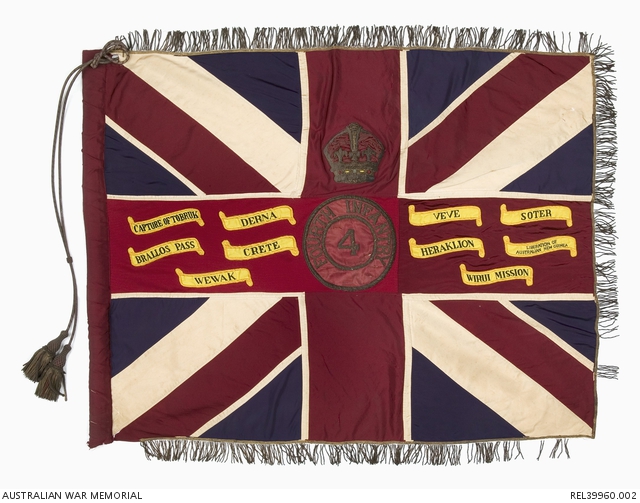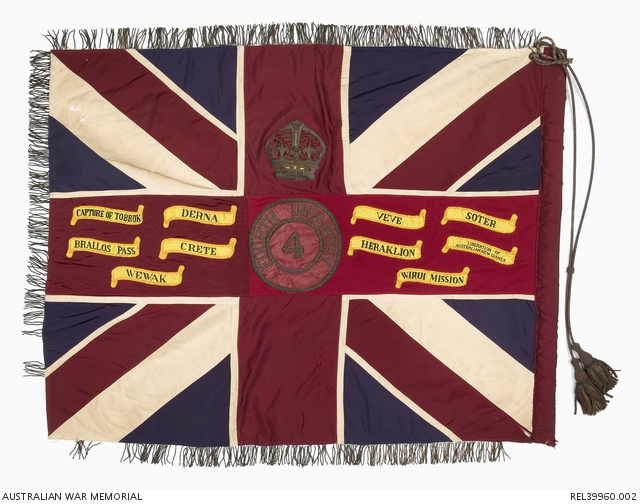| Accession Number | REL39960.002 |
|---|---|
| Collection type | Heraldry |
| Object type | Colour |
| Physical description | Cotton, Gold bullion thread, Silk, Synthetic, Velvet |
| Maker |
Unknown |
| Date made | c 1926-1927 |
| Conflict |
Second World War, 1939-1945 Period 1920-1929 First World War, 1914-1918 |
King's Colour : 4th Battalion, AIF


Double sided red, blue and white silk King's Colour in the form of a Union flag, with gold bullion fringe on the fly and upper and lower edges, and a pair of gold bullion and crimson silk tassels attached to the top of the hoist. In the centre, in gold bullion embroidery, is 'FOURTH INFANTRY' within two circles. The number '4', also in gold, is embroidered in the inner circle. Above is an appliqued king's crown in gold bullion and cotton embroidery, and red silk velvet. Ten battle honours for the Second World War, embroidered in black on yellow silk scrolls, are appliqued to the central red horizontal section of the Colour. On the fly end are the honours 'CAPTURE OF TOBRUK', 'DERNA', 'BRAILLOS PASS', 'CRETE' and 'WEWAK'. On the hoist end are the honours 'VEVE', 'SOTER', 'HERAKLION', 'LIBERATION OF AUSTRALIAN NEW GUINEA', and 'WIRUI MISSION'. Two thirds of the central red section have been replaced with modern synthetic fabric in the same colour as the original silk.
This King's Colour is one of a pair (see Regimental Colour at REL39960.001) presented to the 4th Infantry Battalion (Australian Rifles) in 1927 to recognise the service of the 4th Australian Infantry Battalion AIF in the presence of veterans of the wartime AIF battalion.
The 4th Battalion, AIF, a New South Wales unit, part of the 1st Infantry Brigade, was raised soon after war was declared in 1914 and sailed for Egypt two months later, with the first convoy of troops to leave Australia. The battalion took part in the Anzac Landing on 25 April 1915, as part of the second and third waves, and was tasked with defending the beachhead. In August, together with the rest of the Brigade it led the charge at Lone Pine.
After the evacuation from Gallipoli the battalion trained in Egypt before moving to France for service on the Western Front in March 1916. Its first major action was at Pozieres on the Somme in July 1916. Later the battalion fought at Ypres, Belgium before returning to the Somme for winter. The battalion took part in a short period of mobile operations following the German withdrawal to the Hindenburg Line in early 1917. later in the year it fought in the increasingly difficult condition endured during the third battle of Ypres. In 1918 the battalion returned to the Somme and helped to stop the German spring offensive in March and April. It took part in the final offensives against the Germans, launched near Amiens on 8 August 1918. It was withdrawn for rest and reorganisation at the end of September and was still out of the line when the war ended on 11 November. During the war the battalion suffered 3,485 casualties, of whom 1,293 were killed.
The King's Colour also represents the Second World War service of 2/4th Australian Infantry Battalion, whose battle honours were added to it in the late 1950s after the honours for Australian units serving in the conflict had been approved.
The 2/4th Battalion was raised soon after the beginning of the war in 1939, and was part of the 6th Division. The battalion left Sydney for service in the Middle East in January 1940 and trained in Egypt and Palestine in preparation for campaigns agains the Italians in Libya. In January 1941 it fought at Bardia, Tobruk and Derna. In early April the battalion, with the rest of 6th Division was deployed to Greece to resist the anticipated German invasion. It fought a fiece battle at Vevi in northern Greece on 11 and 12 April before withdrawing through a series of rearguard actions until it was evacuated by sea to Crete on 26 April. Here the battalion eventually joined the force defending Heraklion airfield. When German paratroopers landed there on 20 May they were overcome in the area around the airfield, but later gained ground around the defended area. This, combined with German successes elsewhere on the island caused the evacuation of the battalion by sea on 29 May.
After regroupoing and training in Palestine the battalion joined the force garrisoning Syria until January 1942. They arrived back in Australia on 27 March and in June were deployed to the defence of Darwin until they rejoined 6th Division a year later in north Queensland. In November 1944 the battalion landed at Aitape, New Guinea to undertake its only campaign against the Japanese, between April and July 1945. THe battalion captured Wewak on 10 May before moving inland to clear the foothills of the Prince Alexander Range. Following the end of the war the battalion was disbanded at Brisbane on 12 November 1945.
This Colour, and its pair, were laid up at Christ Church, Cootamundra, NSW on 31 July 1960. They were transferred to St Anne's Church, Strathfield, in Sydney on 14 March 1970, before being transferred to the Australian War Memorial in March 2009.